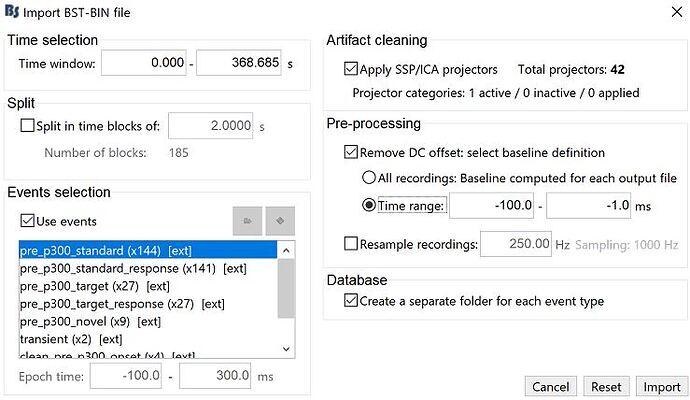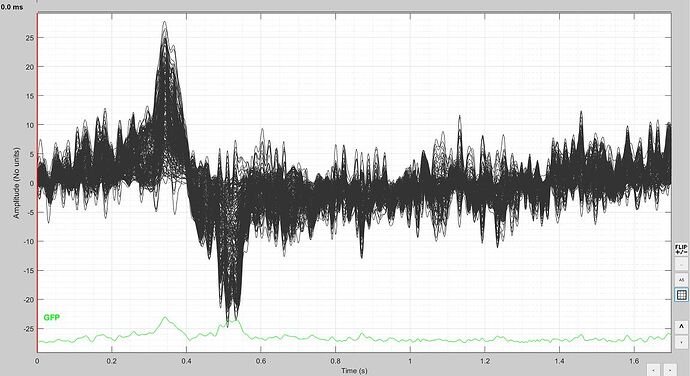I have designated each trial for a fixed period (-100 _ +1600 ms), however, after epoching the raw data to its events ( without splitting in time block), the result shows 0-1700 ms blocks. I would like to know which of these suppositions is correct?
-
Do I have to change some settings before epoching in order to see the pre-stimulus period?
-
100 ms at the beginning of each trial is supposed to be the pre-stimulus period!
-
The pre-stimulus period is calculated and is not shown!
figure 1. the window of epoching command
figure 2. averaged of some trials
Thanks
Mona
Your events are "extended events", their duration is already defined and can't be redefined when epoching the data. You probably noticed that the parameter "epoch time" is disabled when importing them.
https://neuroimage.usc.edu/brainstorm/Tutorials/EventMarkers#Extended_events
If you want to epoch your data differently, you need first to convert them to simple events (process "Events > Convert to simple events"), and then the import options window will allow you to define an "epoch time" for them.
Thanks Francois for explanation
May I need to describe it with more details. I don't want to redefine epoch time. I'd rather to see pre-stimulus period after epoching, which I have already defined -100 ms as pre-stimulus. So, do you think the first 100 ms of my epochs are related to pre-stimulus preiod?
So, do you think the first 100 ms of my epochs are related to pre-stimulus preiod?
How would I know?
You're supposed to know what the markers in your recordings represent.
Hi Francois
As the marker is representing at 0 ms, I would like to know if there is the possibility in Brainstorm that the first 100 ms as pre-stimulus, is included in epoched data? ( because each trial was coded and defined -100 to 1600 ms, before importing to BS) , so in that case, I have to find the latency of ERP component from 100 ms( instead of 0 ms)
I have also another question regarding events:
I have defined stimuli events and response events. Response events are inside the duration of stimuli events ( 400 ms after onset of stimuli). I would like to know if this partially overlapping of two events can be detected separately in Brainstorm?
As the marker is representing at 0 ms, I would like to know if there is the possibility in Brainstorm that the first 100 ms as pre-stimulus, is included in epoched data? ( because each trial was coded and defined -100 to 1600 ms, before importing to BS) , so in that case, I have to find the latency of ERP component from 100 ms( instead of 0 ms)
Convert your events to simple events, then you'll be able to epoch them the way you want.
I have defined stimuli events and response events. Response events are inside the duration of stimuli events ( 400 ms after onset of stimuli). I would like to know if this partially overlapping of two events can be detected separately in Brainstorm?
Look at the processes in the Events category, they are all documented in the option window when you select them in the process editor. With "Detect multiple responses", "Combine stim/response" or "Group by time", you should be able to find a way to do what you want.
Dear Francois
Thank you for your suggestions.
1)Can you explain me what is the advantages of "combine stim/response " relates to two separate events that is defined by onset and duration?
2) Does partially overlapping of stim and response have any effect on ICA ?
Best regards
Mona
Sorry for the response delay.
Have you figured out the answers to your questions?
Hello Francois
Thanks for caring issues from all of your software's users. Unfortunately, no; and if you may guide me, it would help me a lot to know the reason for what I am doing!
1)Can you explain me what is the advantages of "combine stim/response " relates to two separate events that is defined by onset and duration?
I'm sorry, I don't understand your question.
Can you please describe precisely what you have trouble doing? Please include screen captures of 1) what your signals and events look like, 2) the options of the processes you've been trying so far, 3) the current output you obtain together with the explanation of why it doesn't satisfy you.
Does partially overlapping of stim and response have any effect on ICA ?
Do you mean that you have inter-stimulus interval that its too short and you don't know how to process your signals?
Ideally, the ICA would give you orthogonal spatial components that are uncorrelated in time. The entire experimental design and the quality of the recordings influence what an "independent component" will be. So everything impacts the ICA...
If your experiment is poorly designed and the next stim is present while the previous one is still being processed (for the latencies you are interested in), there is no signal cleaning technique that can help you fix this.

